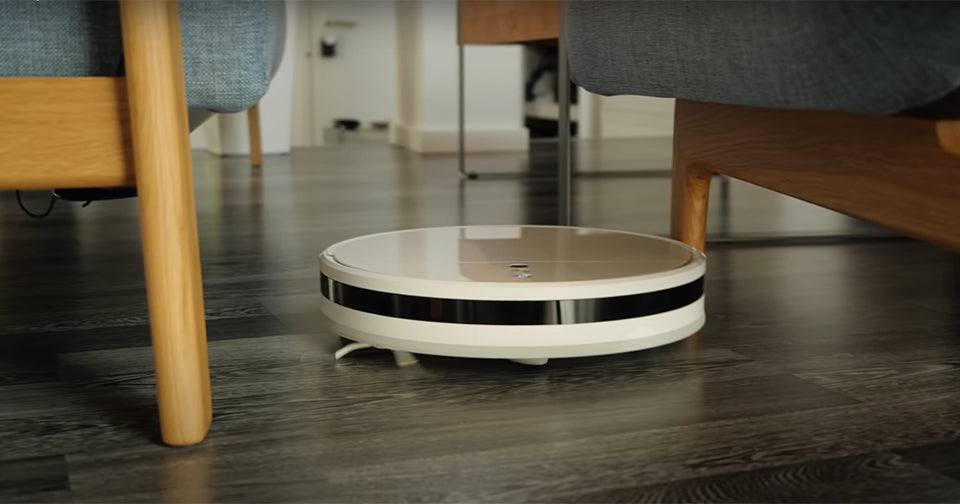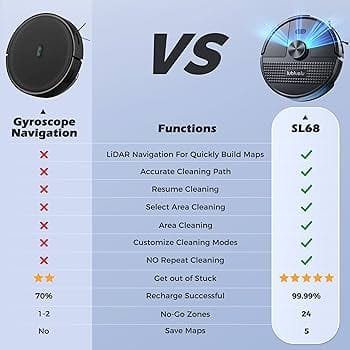Lidar and gyroscope are two key technologies in robot vacuums. Both have unique strengths, making them ideal for different needs.
Robot vacuums have become essential in many homes. They save time and keep floors clean. But with so many options, choosing the right one is tough. Lidar and gyroscope are two popular navigation systems. Understanding their differences helps in making the right choice.
Lidar uses light to map rooms, while gyroscopes track movement. Each has pros and cons. This guide will explain both technologies. It will help you decide which is better for your home. So, let’s dive into the comparison and make vacuum shopping easier.

Credit: global.dreametech.com
Lidar Technology
Lidar technology is becoming popular in robot vacuums. It helps them navigate homes with precision. This tech uses light detection and ranging to create maps of the area. This allows the vacuum to clean more effectively. Let’s dive deeper into how it works.
How Lidar Works
Lidar sends out laser beams that bounce off objects. The sensor measures the time it takes for the light to return. This data helps the robot vacuum to create a detailed map. The vacuum then uses this map to plan the best cleaning path.
Advantages Of Lidar
Lidar offers several benefits. It provides high accuracy in mapping. This means the vacuum can avoid obstacles with ease. Lidar also works well in different lighting conditions. Even in the dark, the robot can navigate smoothly. The technology allows for efficient cleaning, saving time and energy.
Limitations Of Lidar
There are some drawbacks to Lidar. It can be expensive. This may make Lidar-equipped vacuums costlier. Sometimes, Lidar might struggle with very thin objects. These can be hard for the sensors to detect. Also, dust or dirt on the sensor can affect performance. Regular maintenance is necessary to keep it working well.

Credit: www.therobotreport.com
Gyroscope Technology
Gyroscope technology offers precise navigation by detecting orientation changes. Lidar provides detailed mapping using laser sensors. Comparing both helps determine the best robot vacuum for efficient cleaning.
When choosing a robot vacuum, understanding the technology behind its navigation is crucial. One such technology is the gyroscope. Gyroscopes are often found in budget-friendly robot vacuums, but don’t let the cost fool you—these small devices play a significant role in how your vacuum navigates your home.How Gyroscopes Work
Gyroscopes measure the orientation and angular velocity of the robot vacuum. They work by using the principle of angular momentum. When the vacuum moves, the gyroscope senses changes in direction and speed.The data from the gyroscope helps the vacuum keep track of its movements. This ensures that it doesn’t just wander aimlessly but follows a somewhat systematic path.Advantages Of Gyroscopes
Gyroscopes are cost-effective. They provide decent navigation capabilities without breaking the bank.They are excellent for smaller spaces. If you have a small apartment, gyroscope technology might be all you need.Gyroscopes are simple yet effective. They require less processing power, which can be beneficial for more basic robot vacuum models.Limitations Of Gyroscopes
Gyroscopes can struggle in larger, more complex spaces. They don’t create detailed maps, which limits their efficiency in bigger homes.They are less precise compared to Lidar. While they track movement, they don’t offer the same level of accuracy.Gyroscope-based vacuums may need more frequent manual intervention. If you have lots of furniture or obstacles, you might find yourself rescuing your vacuum more often.In essence, gyroscope technology offers a budget-friendly and straightforward solution for robot vacuum navigation. However, consider the size and complexity of your home before deciding if this is the right choice for you. Have you ever wondered how your vacuum keeps track of where it’s been? Gyroscopes might just be the unsung hero in your cleaning routine.Performance Comparison
Comparing Lidar and gyroscope technology in robot vacuums reveals important differences. Performance is key for efficient cleaning. Let’s explore the performance based on accuracy, precision, speed, and efficiency.
Accuracy And Precision
Accuracy and precision are vital for effective cleaning. Lidar technology uses lasers to map rooms. This creates highly accurate maps. Lidar sensors detect obstacles with great precision. Robot vacuums with Lidar avoid bumping into objects. They navigate smoothly around furniture.
Gyroscope technology relies on sensors that measure rotation. It offers basic navigation capabilities. Gyroscopes track the robot’s movement. They help maintain direction. Yet, they may not detect small objects. This can result in less precise cleaning.
Speed And Efficiency
Speed and efficiency determine how fast the cleaning is done. Lidar-equipped robots clean quickly. They plan efficient routes. This reduces cleaning time. Lidar technology helps robots avoid obstacles. It ensures thorough cleaning in less time.
Gyroscope-based robots follow simpler navigation patterns. They may take longer to clean the same area. Their efficiency is lower compared to Lidar. They might miss spots or go over the same area twice. This increases cleaning time.
Cost Analysis
When considering robot vacuums, understanding the cost differences between Lidar and Gyroscope technology is vital. Both technologies have unique financial implications. This section will break down the initial investment and long-term maintenance costs for each.
Initial Investment
Lidar technology often requires a higher upfront cost. These sensors are advanced. They offer precise mapping and navigation. This precision increases their price. Robot vacuums with Lidar technology can cost more than those with gyroscopes.
Gyroscope-based vacuums are generally cheaper. They use simpler technology. This makes them more affordable. For budget-conscious buyers, gyroscopes might be more appealing.
Long-term Maintenance
Long-term maintenance can vary. Lidar sensors are delicate. They may need repairs or replacements over time. This can add to the overall cost. Keeping the sensors clean is also important.
Gyroscope technology is more robust. These vacuums tend to have fewer issues. Maintenance costs are usually lower. They may not need frequent repairs. This can save money over time.
User Experience
Comparing Lidar and Gyroscope technology in robot vacuums can significantly impact user experience. Each technology offers distinct advantages and challenges. Understanding these differences helps users make informed decisions.
Ease Of Use
Robot vacuums with Lidar technology map rooms accurately. This results in efficient cleaning patterns. Users often find them easy to set up and operate. The detailed mapping allows for precise cleaning schedules.
Gyroscope-based vacuums are generally simpler. They rely on basic navigation. This makes them less accurate but easier to use for quick clean-ups. Users who prefer straightforward devices may favor this type.
Customer Feedback
Customers appreciate the advanced navigation of Lidar-equipped vacuums. They often praise the thorough cleaning and smart mapping. This technology tends to receive higher ratings for performance.
On the other hand, gyroscope-based vacuums receive mixed reviews. Some users find them adequate for small spaces. Others note they miss spots or get stuck. Feedback highlights the simplicity but also the limitations.

Credit: www.amazon.com
Future Trends
The future of robot vacuums is promising with rapid advancements in technology. LiDAR and gyroscope technologies are at the forefront of this evolution. Understanding future trends helps users make informed choices. Let’s explore the emerging technologies and potential improvements in these systems.
Emerging Technologies
Artificial intelligence (AI) integration is a key emerging trend. AI enables smarter navigation and better obstacle avoidance. This technology learns from past cleaning sessions. It adapts to different floor plans and cluttered environments.
Another emerging technology is sensor fusion. This combines data from LiDAR and gyroscope sensors. The result is a more accurate mapping and positioning system. This fusion enhances the robot vacuum’s efficiency.
Edge computing is also gaining traction. It processes data on the device itself. This reduces latency and improves real-time decision-making. Edge computing enables faster response to changes in the environment.
Potential Improvements
Battery life is a critical area for improvement. Longer battery life means extended cleaning sessions. It reduces the need for frequent recharging. Future models may feature more efficient batteries.
Noise reduction is another potential improvement. Quieter operation makes robot vacuums more user-friendly. Advanced motor designs and better insulation can achieve this goal.
Improved software updates offer another avenue for enhancement. Regular updates can refine algorithms and introduce new features. This keeps the robot vacuum up-to-date without needing new hardware.
Enhanced connectivity options will also play a significant role. Better integration with smart home systems is a priority. This includes voice control and seamless operation with other devices.
Lastly, self-cleaning capabilities could become more common. This feature reduces maintenance and increases convenience. It makes the robot vacuum more autonomous and user-friendly.
Frequently Asked Questions
Are Robot Vacuums With Lidar Better?
Yes, robot vacuums with LiDAR offer better navigation. They accurately map areas, avoid obstacles, and clean efficiently.
Which Is Better Gyro Navigation Or Lidar?
Gyro navigation excels in stability and durability, ideal for long-term use. LiDAR offers higher accuracy and better mapping capabilities. Choose based on your specific needs.
Which Robot Vacuum Has The Best Mapping System?
The iRobot Roomba s9+ has the best mapping system. It uses advanced sensors and smart mapping technology for efficient cleaning.
Do Shark Robot Vacuums Use Lidar?
Yes, Shark robot vacuums use LiDAR technology. This helps them navigate and map your home efficiently.
Conclusion
Choosing between Lidar and Gyroscope technology for robot vacuums depends on your needs. Lidar offers precise navigation and mapping, ideal for complex layouts. Gyroscopes provide a cost-effective solution for simpler spaces. Both technologies have their strengths and weaknesses. Consider the size and complexity of your home.
Evaluate your budget and cleaning priorities. Understanding these factors helps you make an informed decision. The right choice ensures efficient and effective cleaning. Happy vacuuming!

